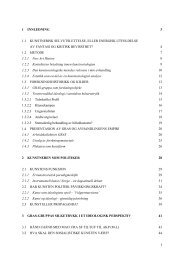2003 Rogaland museum - Gras Katalog - Victor Lind
2003 Rogaland museum - Gras Katalog - Victor Lind
2003 Rogaland museum - Gras Katalog - Victor Lind
Create successful ePaper yourself
Turn your PDF publications into a flip-book with our unique Google optimized e-Paper software.
pop is their rejection of the aesthetic values of the 1950s, it is tempting to assume<br />
that both Pop art and Non-pop shared none of the same intentions with its art historical<br />
grandfather and father, respectively. Obviously, there is a substantial difference<br />
at play here, one that also relates to the Pop art inspired works of GRAS.<br />
Mark Rothko’s abstract sublimes and Barnett Newman’s images, that he would only<br />
begin to title by the late 1950s drawing associations to the feelings he had when he<br />
created them, are quite distant from Warhol’s multitude of Marilyn Monroes and car<br />
accidents or Wesselmann’s nudes. Where the former attended to the humanistic<br />
values of the individual, the latter was more apt to attend to society at large through<br />
the popular image. There was, simultaneously, an important shift in American<br />
culture at that time. By the late 1950s, consumerism and mass culture were allpervasive<br />
in America. An example of this is seen in the growth of television sales<br />
on Madison Avenue in New York between 1949 and 1951; the escalation was from<br />
12.3 million to 128 million dollars in sales revenue.<br />
GRAS, however, not only attended to society at large when such was present<br />
as subject matter; they also attended to specific political issues as well. But although<br />
the GRAS group attended in part to the political interests prominent in the<br />
1970s, it is quite a different matter to associate the whole production of GRAS to a<br />
common political manifesto. Rather, their common socio-political foundation allowed<br />
for the range of visual vocabulary that the group represents. <strong>Lind</strong>’s strong, politically<br />
inclined subject matter seen in Alle ting har to sider (1972), for example, is<br />
absent in his contribution to the GRAS folder. This latter work, Fest (1971) retains<br />
its simple geometric imagery while it denies, in the most part, any political associations;<br />
Eva Lange’s Frø (1971) does the same. What more, to assume that the presence<br />
of political subject matter is the only way in which politics can be present in<br />
the art of GRAS is to underestimate not only the individuals of the group but also<br />
the extent to which the socio-political situation permeated the group and their intentions.<br />
The silkscreen technique itself and the multiple production of each piece<br />
gained a politicised value, as this act of creation not only denied the one-of-a-kind<br />
status of art, it also simultaneously denied the economic hierarchy of the art world.<br />
With regards to the artistic form, the more pure Hard Edge examples present<br />
in the group, such as Lay Lady Lay and Krogstad’s Untitled, need not, it thus<br />
has been found, be considered as too distant from remaining GRAS examples even<br />
though the socio-political situation that founded them as well is not as clearly present<br />
in the subject matter. The result, then, of this brief art historical study is not so<br />
19



